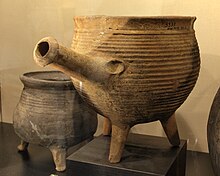Jydepott
A Jydepott ( Danish ), also Jütepott , Suurpott ( Low German ), Taternpott or Taterntopf denotes unglazed grapes ( cooking pots ) made of black- fired clay , which, especially in southern Denmark and northern Schleswig-Holstein until the 19th century, remained almost unchanged for many centuries were in use.
background

Jydepötte are made of unglazed ceramic , they were molded from clay and fired in a reducing atmosphere in the absence of oxygen, which gave them their characteristic black color. Cooked was with the Jydepötten either on the fire of an open hearth or wood stoves. With the disappearance of wood stoves and the advent of gas and electric stoves, the Jydepötte lost its importance as cookware. Jydepötte are said to be used primarily for cooking and storing black- sour and sour meat dishes, hence the name Suurpott ; have been suitable.
The main areas of distribution were on the Jutland peninsula and Schleswig-Holstein, but they were, albeit less often, in regions further south. In shape and structure, Jydepötte resemble ceramic cooking pots (grapes) of the Middle Ages . Often these pots were not made by potters, but under simple conditions by the housewives themselves. They were not formed on a potter's wheel , but mostly free-hand. To do this, a lump of blue clay was formed on a damp wooden board lying on his knees. After drying, handles or feet were attached and the surfaces smoothed. After the final drying, the vessels were burned in a pit fire or in a kiln.
Due to their archaic appearance and their striking similarities with historical ceramic vessels, Jydepötte aroused the interest of archaeologists at the beginning of the 19th century. Among other things, the prehistoric Johanna Mestorf traveled to Schleswig-Holstein farms in order to purchase these pots, which the farmers used every day, for the museum. Some farmers used antique pots that were several hundred years old. In 1886 Mestorf reported about a woman Lühmann from Hindorf ( Süderdithmarschen district ), who used the burial urns of a burial ground in her garden as needed and thus also looked after neighbors and friends. Whenever one of the women asked for a "swarten pot", Ms. Lühmann took the spade, went into the garden and dug one up.
review
A mocking poem from the times of the German-Danish War around 1864 names the black-burned Jydepötte:
Do you know the land despised by God,
where shoes are made of wood,
where black pots are burned
and where butter is called Smör?
literature
- Jydepötte - Suurpötte - Tatern pots . In: Helms Museum (ed.): Information sheets of the Helms Museum . No. 44 April 1980.
- Rüdiger Articus: Archaeological finds from the Schwan Pharmacy Husum, Großstrasse 21 . In: Husum booklet . Husum Druck- und Verlagsgesellschaft, Husum December 1978, p. 4–8 ( Online [PDF; 1.1 MB ; accessed on October 16, 2012]).
- Andreas G. Jensen: Jydepotten: from Lands ældste Haandværk . In: Vort lands aeldste haandvaerk . Levin & Munksgaard, Copenhagen 1924 (Danish).
- Johanna Mestorf : The manufacture of the so-called Jutian Tatern Pots . In: Archives for Anthropology . No. 11 , 1879, p. 453 ff .
Web links
- Model of a larger than life Jydepot on a spinning top in Grindsted, Denmark